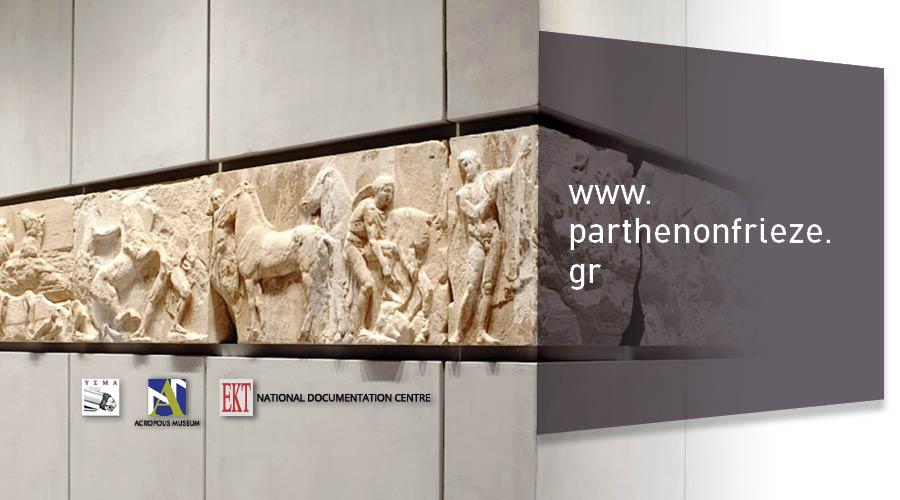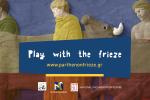
The world famous Parthenon frieze is available online for everyone to explore in a new, interactive, bilingual and easy-to-use web application. At www.parthenonfrieze.gr both citizens and scientists have the opportunity to view this unique work of art as a whole. The application brings together photos and descriptions of all the surviving frieze fragments from the Acropolis Museum and museums abroad.
The Parthenon frieze, which forms a continuous band with scenes in relief that encircles the upper part of the temple wall, shows the procession toward the Acropolis during the Great Panathenaia, the biggest festival of Ancient Athens. Shown in the procession are some 378 human figures, men and women, on horses, chariots and on foot, carrying offerings: more than 200 animals and objects to be offered to Athena, the city’s patron.
The application, which offers users an interactive browsing experience, was implemented thanks to the fruitful and long-term cooperation of three organizations: the National Documentation Center (EKT), the Acropolis Museum and the Acropolis Restoration Service (YSMA). EKT upgraded the web application www.parthenonfrieze.gr, populated it with YSMA’s archival photographic content and endeavored to use all the latest technologies to allow for a rich, immersive virtual experience of the Frieze.
The application incorporates all the latest accessibility features, following best practice of responsive web design and user-centric UI / UX. Practically, this means one can access it from all smart, desktop and mobile devices and reach the same level of detail in an adaptable user-friendly interface.
The application is organized in four sections. There is a section about the actual temple, "The Parthenon", with information and videos about the architecture and sculptural decoration of the temple. In the section "About the Frieze" one can find general information about the history, the design, the meaning and creation of the frieze.
The "Explore the frieze" section gives the opportunity for a more thorough exploration of the frieze, by selecting an actual fragment from each of the 4 sides of the temple (West, North, South and East) and accessing specific content. Finally, one can opt for one of the "Thematic Tours", which focus on the various stages and elements of the Panathenaia festival procession: the preparation of the procession, the Horsemen and chariots participating, the procession carrying the offerings and animals to be sacrificed and finally the Peplos closing ceremony in the presence of the Gods of Olympus.
Researchers and specialists can find in the application all the documentation and an extensive glossary for their needs, whereas citizens and interested parties can have a structured, informative experience learning about this unique archaeological monument.
From the 160 meters of the Frieze, the British Museum in London holds the majority, 80 metres, and the Acropolis Museum in Athens another 50. One block is in the Louvre and several fragments are scattered in other museums around Europe: Palermo, the Vatican, Heidelberg, Vienna and Munich whereas some blocks are destroyed. At parthenonfrieze.gr one can find rich, billingually annotated photographic content about all the remaining blocks of the Frieze together with surviving drawings of J. Carrey (1674) and J. Stuart (1751), offering a way towards virtually and conceptually reconstructing the monument.
In January 2022 the "Fagan fragment" from the Antonino Salinas Museum in Palermo returned to Athens to be exhibited for 8 years at the Acropolis Museum and took its place in the eastern frieze of the Parthenon, where the Gods of Olympus are represented. Until a physical reunion of all the surviving fragments of the Frieze in their place of origin is possible, history enthusiasts can explore the virtually reunited Frieze in EKT’s web application.
The world famous Parthenon frieze is available online for everyone to explore in a new, interactive web application. At https://t.co/LopCDu9BrQ both citizens and scientists have the opportunity to view this unique work of art as a whole.
🔎 https://t.co/d1vG2IODLS pic.twitter.com/jkRpsCevIG— ΕΚΤ (@EKTgr) March 11, 2022
About the Parthenon Frieze
The Parthenon frieze, with a total length of 160 meters and a height of almost 1 meter, was designed by the sculptor Pheidias to form a continuous band with scenes in relief that encircles the upper part of the cella, the main temple, within the outer colonnade. The subject of a procession was selected, as the space that needed to be decorated was long and narrow, so only a multi-figure composition would work.
The subject of the Parthenon frieze was chosen to be the procession of the Panathenaia, the final act of a day-long festival devopted to the goddess Athena. The Frieze consisted of 115 blocks, of various sizes, with continuous relief representations of people and animals. The composition included 378 figures, gods, heroes of the city, lords, citizens, men and women, children, young and old, as well as more than 200 animals, mainly horses, but also oxen and rams.
There are four sections: the preparation of the procession, the main procession with the line of horsemen and chariots, the procession of offerings and animals for sacrifice and the main worship with the delivery of the veil to the goddess.
The procession to Zoforos starts from the southwest corner of the temple and is divided into two groups that run east. One line continues along the south side, while the other, after crossing the west side, continues along the north side and both end on the east side. On the west and north sides the figures walk from the right to the left of the viewer, while on the south from the left to the right.
A longstanding collaboration with important results and benefits
The Acropolis Restoration Service, the Acropolis Museum and EKT have, for the last twenty years, through their multifaceted collaborative activities, mapped a coordinated course in the digital agenda of the country, providing the public with a number of cutting edge digital content infrastructures.
The collaboration of the three organizations began in 2003 when the virtual representation of the Parthenon Frieze was released for the first time in CD-ROM format. In 2009 a standalone website was developed with Flash technologies with enriched texts and educational applications for Frieze.
Following the international Open Access trends, in 2010a dedicated Parthenon Frieze repository was launched, in addition to the respective website, while in 2011 the EKT information systems hosted the website www.acropolis-athena.gr which was created by YSMA in collaboration with the Acropolis Museum and the Bodossakis Foundation. Two years later, the repository of educational content for the Acropolis was delivered to the educational community of the country, with rich material from the Information and Education Department of YSMA.
In 2016, EKT developed the YSMA repository, with archival material from the restoration programs of the Acropolis and an open catalog of the YSMA library was offered to the public (through the openABEKT digital cloud infrastructure). In the same year, YSMA repository was aggregated in SearchCulture.gr, the aggregator of digital cultural content. A few years later, all YSMA archives were semantically enriched and made available, through EKT to the European digital library Europaana.
In 2022 YSMA, the Acropolis Museum (bodies of the Ministry of Culture and Sports) and EKT (body of the Ministry of Digital Government) collaborate again and provide the interested public with a cutting edge web application for the Parthenon Frieze and the virtual representation of the surrounding temple blocks. In the near future the content of this application will be enriched with new digital collections.











